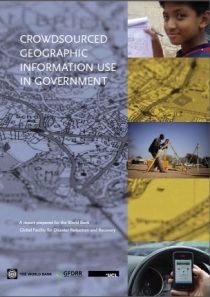Crowdsourced Geographic Information in Government
Today marks the publication of the report ‘crowdsourced geographic information in government‘.  The report is the result of a collaboration that started in the autumn of last year, when the World Bank Global Facility for Disaster Reduction and Recovery(GFDRR) requested to carry out a study of the way crowdsourced geographic information is used by governments. The identification of barriers and success factors were especially needed, since GFDRR invest in projects across the world that use crowdsourced geographic information to help in disaster preparedness, through activities such as the Open Data for Resilience Initiative. By providing an overview of factors that can help those that implement such projects, either in governments or in the World Bank, we can increase the chances of successful implementations. To develop the ideas of the project, Robert Soden (GFDRR) and I run a short workshop during State of the Map 2013 in Birmingham, which helped in shaping the details of project plan as well as some preliminary information gathering. The project team included myself, Vyron Antoniou, Sofia Basiouka, and Robert Soden (GFDRR). Later on, Peter Mooney (NUIM) and Jamal Jokar (Heidelberg) volunteered to help us – demonstrating the value in research networks such as COST ENERGIC which linked us.
The report is the result of a collaboration that started in the autumn of last year, when the World Bank Global Facility for Disaster Reduction and Recovery(GFDRR) requested to carry out a study of the way crowdsourced geographic information is used by governments. The identification of barriers and success factors were especially needed, since GFDRR invest in projects across the world that use crowdsourced geographic information to help in disaster preparedness, through activities such as the Open Data for Resilience Initiative. By providing an overview of factors that can help those that implement such projects, either in governments or in the World Bank, we can increase the chances of successful implementations. To develop the ideas of the project, Robert Soden (GFDRR) and I run a short workshop during State of the Map 2013 in Birmingham, which helped in shaping the details of project plan as well as some preliminary information gathering. The project team included myself, Vyron Antoniou, Sofia Basiouka, and Robert Soden (GFDRR). Later on, Peter Mooney (NUIM) and Jamal Jokar (Heidelberg) volunteered to help us – demonstrating the value in research networks such as COST ENERGIC which linked us.
The general methodology that we decided to use is the identification of case studies from across the world, at different scales of government (national, regional, local) and domains (emergency, environmental monitoring, education). We expected that with a large group of case studies, it will be possible to analyse common patterns and hopefully reach conclusions that can assist future projects. In addition, this will also be able to identify common barriers and challenges.
We have paid special attention to information flows between the public and the government, looking at cases where the government absorbed information that provided by the public, and also cases where two-way communication happened.
Originally, we were aiming to ‘crowdsource’ the collection of the case studies. We identified the information that is needed for the analysis by using few case studies that we knew about, and constructing the way in which they will be represented in the final report. After constructing these ‘seed’ case study, we aimed to open the questionnaire to other people who will submit case studies. Unfortunately, the development of a case study proved to be too much effort, and we received only a small number of submissions through the website. However, throughout the study we continued to look out for cases and get all the information so we can compile them. By the end of April 2014 we have identified about 35 cases, but found clear and useful information only for 29 (which are all described in the report). The cases range from basic mapping to citizen science. The analysis workshop was especially interesting, as it was carried out over a long Skype call, with members of the team in Germany, Greece, UK, Ireland and US (Colorado) while working together using Google Docs collaborative editing functionality. This approach proved successful and allowed us to complete the report.
You can download the full report from UCL Discovery repository
